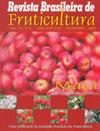Growth ofCampomanesia adamantium (Cambess.) O. Berg, native to Brazilian Cerrado, with green manure in agroecological system contributes to the preservation of the species
IF 0.9
4区 农林科学
Q4 HORTICULTURE
引用次数: 0
Abstract
Abstract Campomanesia adamantium (guavira) is a native plant of the Brazilian Cerrado used both as food and as medicine. The plant has undergone indiscriminate overexploitation in its habitat, which, in association with fires and deforestation, puts the species at risk of extinction. To preserve the species, in situ and ex situ management actions are required and agroecological practices associated with green manuring is the recommended system. In this study, we investigated the development of C. adamantium grown with the green manures Stylosanthes macrocephala, Pueraria phaseoloides, Calopogonium mucunoides, and Cajanus cajan, as well as the chemical and microbiological properties of the soil. The green manures had the highest production of fresh and dry masses at the second cut and C. mucunoides, S. macrocephala, and P. phaseoloides presented the highest nutrient concentrations. C. mucunoides mass decomposed rapidly and influenced the chemical properties of the soil, with a greater role of soil microorganisms in the biochemical process of decomposition of the organic residues. The bestdeveloped and highest yielding plants with the highest leaf nutrient content were obtained for C. adamantium grown with the green manures C. mucunoides and S. macrocephala. The results showed that C. adamantium responded positively to the use of the green manure C. mucunoides with increased leaf production. This agroecological cultivation to contributes for the preservation of C. adamantium and the appropriate use of the natural resources of the Cerrado.camomanesia adamantium (Cambess.)生长原产于巴西塞拉多的O. Berg在农业生态系统中使用绿肥有助于该物种的保护
番石榴(Campomanesia adamantium)是巴西塞拉多(Cerrado)的一种原生植物,既可作为食物也可作为药物。这种植物在其栖息地经历了不分青红皂白的过度开发,再加上火灾和森林砍伐,使该物种面临灭绝的危险。为了保护该物种,需要采取就地和移地管理行动,并建议采用与绿色施肥相关的农业生态做法。本研究研究了绿肥料stylosanthmacrocephala、葛根(Pueraria phaseoloides)、Calopogonium mucunoides和Cajanus cajan的生长情况,以及土壤的化学和微生物特性。绿肥在第二次刈割时的鲜块和干块产量最高,而粘草、大头草和相花草的养分含量最高。粘菌团分解迅速,影响土壤的化学性质,土壤微生物在有机残留物分解的生化过程中作用较大。与绿肥粘草和大头草共同生长的金刚木发育最好,产量最高,叶片养分含量最高。结果表明,施用绿肥后,adamantium对绿肥的响应显著,叶片产量增加。这种农业生态栽培有助于C. adamantium的保存和塞拉多自然资源的适当利用。
本文章由计算机程序翻译,如有差异,请以英文原文为准。
求助全文
约1分钟内获得全文
求助全文
来源期刊
CiteScore
1.50
自引率
20.00%
发文量
34
审稿时长
4-8 weeks
期刊介绍:
The Revista Brasileira de Fruticultura (RBF) publishes technical articles and scientific communications in the area of fruit crops, referring to results of original searches and unpublished papers in Portuguese, Spanish or English, and 1 or 2 reviews per edition, of invited authors.

 求助内容:
求助内容: 应助结果提醒方式:
应助结果提醒方式:


